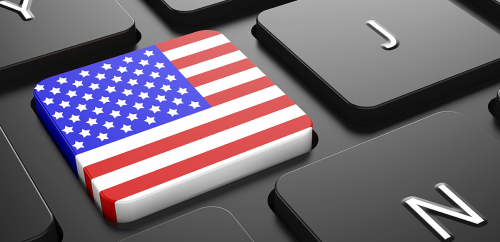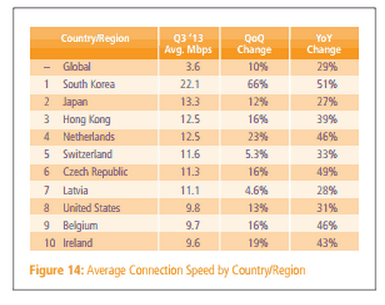Today, Akamai released their latest State of the Internet Report revealing that average broadband speeds in the U.S. jumped 13 percent since last quarter, delivering an overall 31 percent increase year over year. The average broadband speed in the U.S. is now up to 9.8 Mbps, raking us 8th worldwide.
For a nation as large, rural, and spread out as ours, this is a remarkable number. Geographically speaking, all of the other nations with top-ten speeds have far more in common with US states than they do the country as a whole. And while on its own Akamai’s report would be big digital news, today also happened to be the annual State of the Net conference, billed as the largest information technology policy conference in the country. Among a number of panels at the event, Robert Atkinson, President of the Information Technology and Innovation Foundation and Sascha Meinrath, VP & Director of the Open Technology Institute for the New America Foundation discussed the nature of how we measure and report worldwide Internet speeds. The debate provided the perfect platform to better understand what Akamai’s numbers really mean and how we can more accurately meter broadband speed achievements.
Meinrath and Atkinson fundamentally disagree with how broadband is measured and what the latest Akamai report really says about the state of broadband in America. Meinrath feels that 8th place is a middling, “gentleman’s C” ranking, especially when the U.S. was number one a little less than two decades ago. Atkinson says the ranking is quite good, especially considering the U.S. physical landscape and that number eight is well above many European counterparts including Germany, England and France. Meinrath says that unless we invest heavily in establishing ultra-fast gigabit networks, we’ll surely be left behind by other nations. Atkinson says, “not so”, citing not only our above average year-over-year growth, but noting that in many European regions like the Netherlands which already offer home gigabit connections, less than one percent of users sign up for this top tier. He says the smarter way to invest is how U.S. ISPs have been doing for years – by allowing the market to consistently serve slightly ahead of present consumer needs. But where they both agree is on the importance of delivering broadband to more people and making sure users of all stripes and in all places understand how to use broadband to improve their lives. In fact, Atkinson goes as far as to say the international broadband speed panic that Meinrath and others are placing us in is a diversion from the real broadband problem: adoption.
A big part of why we have low adoption, Atkinson says, is because the US has one of the lowest rates of computer ownership of any OECD nation. He says we shouldn’t “get sidetracked” by arguing over mega speeds and instead focus on a goal of connecting 95 percent of Americans to quality broadband and supporting digital literacy programs. This fact is a big part of why cable invests in broadband adoption programs like Comcast’s Internet Essentials, which provides affordable computers and digital literacy training programs.
Akamai’s report shows huge leaps forward for U.S. broadband speed and penetration. While there will always be a debate as to how we measure the Internet and what we as a nation can do to improve our broadband network, the numbers show that we are on the right track.

